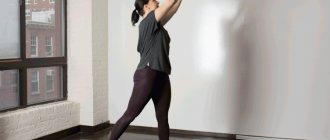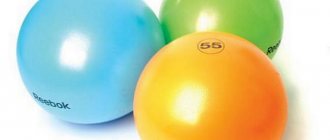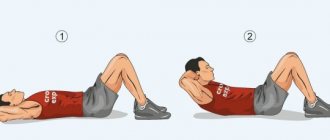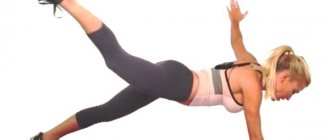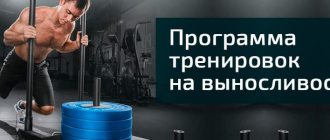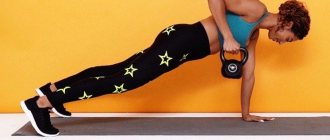Abdominal exercises with a fitball are one of the best ways to give a beautiful shape to your waist and stomach, and perhaps even become the owner of rather convex “cubes”.
Regular exercise with a large ball will help you achieve what is difficult to achieve by pumping up your abs on the floor, bench, or even a special machine.
Abdominal exercises on a fitball - 9 effective exercises
Exercise 1
The exercise effectively works all the abdominal muscles.
Starting position: sit on a fitball, feet flat on the floor, cross your arms over your chest. Stepping your feet, carefully lower yourself forward so that your back is on the ball and your knees are under your ankles, keeping your head up without leaning back. From this position, using an isolated effort of the abdominal muscles, begin a slow twist: first the head, then the shoulders, then the middle of the back until you feel a complete contraction of the abdominal muscles. Emphatically slowly return to the starting position.
At the initial stage, start with 1-2 sets of 8-10 repetitions each. Rest between sets for 45 seconds.
Execution option for beginners
When you can easily master this exercise, move on to a more advanced version.
The starting position is the same, with only one exception - the arms are bent at the elbows and placed on the back of the head, do not cross the fingers. Performing the exercise is similar to the option described above. At this stage, perform the exercise in 3 sets of 12 repetitions each. Reduce rest between sets to 30 seconds.
Execution option for advanced
The third option is even more difficult; move on to it only when you can easily perform the second option of the exercise.
The starting position is the same, with only one exception - the arms are straightened behind the head so that they are located close to the ears, in the hands is a medicine ball (can be replaced with a dumbbell weighing 1-3 kilograms or weights can be used). At this stage, perform the exercise in 2-3 sets of 12-15 repetitions each. If you don’t want to use weights, simply perform the exercise with your arms extended behind your head: 4 sets, first 15, then 20 repetitions. Do not bend your arms while doing this.
Complicated version
Training Recommendations
Be sure to warm up first. Perform the exercises slowly, in 2-3 sets of 10–15 repetitions. For beginners, one approach will be enough. Do not overestimate your strength, otherwise you may not be able to complete the whole complex. It's helpful to add some cardio exercise between sets.
Perform a set of exercises on a fitball regularly, at least three times a week, alternating a day of exercise with one or two days of rest. Only systematic training gives full results. Exercise in moderation, but don't be lazy. Don’t forget to constantly, at least a little, increase the load. If the exercises begin to seem too simple to you, add one more approach.
The ball was originally created for the rehabilitation of people with diseases of the joints and spine, so the fitball can be used for osteochondrosis. But while working on stretching and strengthening your back, monitor your condition and avoid painful sensations. Start with moderate loads. Increase the duration of your workout gradually.
If you have any illnesses, before starting active training with a gymnastic ball, it is advisable to consult a doctor so as not to cause harm to your health.
Exercise 2
The exercise effectively works the rectus and oblique abdominal muscles.
Starting position: sit on a fitball, feet flat on the floor, knees bent. Stepping your feet forward, lie with your back on the ball, place your right hand on the back of your head.
From this position, tensing the muscles of your buttocks, push your pelvis up. Pull your stomach in and lift your upper body. Then turn your right shoulder to the left. Perform all given repetitions first with the right hand, then with the left.
At the initial stage, start with 1-2 sets of 8-10 repetitions each.
As muscle strength develops, increase the number of sets first to 3, then to 4, and the number of repetitions first to 15, then to 20. Be sure to rest between sets: at the initial stage 30 seconds - 1 minute, at a more advanced stage - reduce the rest time to a minimum .
Video training for abs with fitball
This workout is based on raising your legs from a prone position. In this case, the fitball will be clamped between the legs. In this case, not only the abs work - the outer and inner sides of the thigh are actively involved. This will increase your total calorie expenditure during your workout, and you will benefit from even low reps. But rather, this video should be considered as a reminder that will tell you the correct technique and sequence of exercises, but we recommend increasing the number of repetitions as your endurance develops.
Remember that you should choose the right ball - in accordance with your height. When you sit on the stability ball, your thighs should be parallel to the floor.
Exercise 3
The exercise effectively works all the abdominal muscles and also engages the hip flexors.
Starting position: Lie on your back and hold the exercise ball between your ankles, legs straight. Place your hands behind your head and grab any support.
From this position, tightening your abdominal muscles and holding the ball firmly with your feet, pull your knees towards your chest. Then lift your buttocks off the floor. Hold this position for 1-2 seconds, then slowly return to the starting position.
At the initial stage, start with 1-2 sets of 12-15 repetitions each. As muscle strength develops, increase the number of sets to 3-4 and the number of repetitions to 20. Be sure to rest between sets: at the initial stage, 30 seconds - 1 minute, at a more advanced stage, reduce the rest time to a minimum.
Attention: lift your legs only with the force of your abdominal muscles; when performing, try to avoid arching in the lower back; To increase the load, use ankle weights, but reduce the number of repetitions to 12.
Exercise 4
The exercise effectively works all the abdominal muscles, engages the muscles of the buttocks, mid-back, as well as the hip flexors and hamstrings.
Starting position: get down on your knees, body and hips perpendicular to the floor, hands clasped. Without changing the position of your hips, place both hands on the exercise ball. From this position, begin to roll the ball forward. When the body angle approaches 45 degrees, stop, take a deep breath, draw in your stomach and, maintaining the natural curve of your spine, continue to roll the ball away from you until you feel the tension in your abdominal muscles. Then return to the starting position.
Attention: in order not to lose your balance and fall on your stomach on the floor, the speed of rolling out the fitball should be minimal.
Initially, start with 2 sets of 12 repetitions each. As you develop muscle strength, increase the number of sets to 3 and the number of repetitions to 15. Be sure to rest 30 seconds to 1 minute between sets.
Execution option
This embodiment differs only in the initial position of the hands: you lean on the fitball with your hands clenched into a fist.
During training, you can perform either of the two options or do both.
What muscles are involved?
In short - everything. Yes, yes, all the muscles take part during training with such a projectile. But, first of all, the abdominal muscles are involved. When the surface is unstable, people tense these muscles to maintain stability and not fall. Other muscles will also be used to perform different exercises.
Many women know how difficult it is to pump up their lower abs. There are few exercises that are effective for this muscle group. By performing abdominal exercises with a fitball, this problem will quickly disappear for women. You can train them simply by sitting on the ball. When trying to stay on the ball, the muscles of the body are in tension, and microvibrations from the surface of the projectile additionally stimulate muscle work. Due to this, female muscles are trained.
Exercise 5
The exercise effectively works the abdominal muscles.
Starting position: lie on your back with your legs extended. With straight arms, lift the exercise ball above your head.
From this position, tighten your abs and lift your head, neck, and shoulder blades off the floor while moving the ball toward your feet.
Twist your body further forward and pinch the ball with your feet. As you lower your upper body to the floor, simultaneously lift your legs with the ball clasped upward above you. Then grab the ball with your hands and lift it above your head again, and lower your legs to the starting position.
At the initial stage, start with 1-2 sets of 12-15 repetitions each. As muscle strength develops, increase the number of sets to 3.
In the future, the fitball can be replaced with a weighted medicine ball weighing first 1-2 kilograms, then 3-4 kilograms; or use ankle weights.
How to pick up the ball
Anyone can pump up their abs with a fitball, regardless of age. The activity has no age restrictions, and there are practically no health contraindications.
The main thing is to choose the right fitball. Here are the basics to follow:
- If a person’s height is up to 165 cm, then a ball is needed with a diameter of no more than 60 cm.
- When the height is 165-175 cm, you need to purchase a ball with a diameter of 65 cm.
- If you are taller than 175 cm, a ball with a diameter of 70 cm is required.
An incorrectly selected fitball leads to the fact that the exercises performed do not bring the desired result due to the small generated load. A properly selected fitball can form abdominal muscles and reduce waist size.
Exercise 6
The exercise works all the abdominal muscles, but mainly the transverse and oblique internal muscles.
Starting position: lie on the floor, place your arms straight behind your head, and hold the exercise ball between your calves.
From this position, tighten your abs, which will bring your spine into a neutral position. Then inhale, bend your knees slightly and lift the exercise ball with your feet 45° from the floor. Exhaling slowly in five counts, using your abdominal muscles, lift your shoulders and head and reach your hands towards the ball. Continuing to keep your legs suspended, lower your head and shoulders to the starting position. Then lower your legs. This will be one repetition.
At the initial stage, start with 1 set of 10 repetitions. As muscle strength develops, increase the number of sets to 2 and the number of repetitions to 12-15 each.
Be sure to rest 30 seconds to 1 minute between sets.
Hitch
At the end of a set of exercises, be sure to stretch to avoid injury and unnecessary muscle pain. And stretching on the ball is double pleasure. First, it bears your body weight, helping you relax. Secondly, it helps relieve stress from the joints.
Making throws
The next routine involves throwing a medicine ball at a wall. Executes quickly. The pace is explosive.
- Stand in front of a gym wall and throw a medicine ball at it, like you're making a basketball pass. Repeat 10-15 times.
- Stand straight, with your back to the wall, spread your legs wide. Raise your arms above your head, then quickly bend down and throw the medicine ball at the wall between your spread legs.
- While squatting with a medicine ball in your hands, jump forward. Jump 10-15 times or as many times as you can.
- A heavy medicine ball can also be used as a classic kettlebell, lifting it from the shoulders with both hands and one. This is a great workout for the shoulder girdle.
Exercises with this apparatus are effective and differ little in impact from exercises with weights or dumbbells. You can alternate between different workouts, choosing what you like best. After all, each exercise should be performed with pleasure, only then the effect will be maximum.
Exercise 7
Full stretch
Starting position: sit on the fitball, placing your feet at some distance from it. Then lower your hips so that your back, lower back and buttocks rest on the ball at a slight angle. Place your feet slightly wider than your shoulders, bend your knees, and leave your arms hanging down freely.
From this position, while inhaling, straighten your legs and bend in an arc so that the ball is under your back and buttocks, while your feet should remain on the floor.
As you exhale, move your arms straight behind your head and touch the floor with your fingertips. Stay in this position for 30 seconds. Then return to the starting position.
Medicine ball exercises for men
1. Playing with shadows. Everything is very simple here, everything is the same as at basketball practice, we pass the pass to the wall and receive it back. Standing a couple of meters from the wall, we take a step with our right foot and throw a medicine ball from the chest, catch it and return to the starting position.
advertising is not displayed
2. Wall jump. We stand next to the wall (about 1 m away), hold the ball against our chest, then slowly squat down (moving our pelvis back), after which we jump out, touching the wall with a medicine ball (the very top of the wall with straight arms).
3. Long jump. A simple exercise that anyone can do. Holding the ball at chest level, we squat and jump as far as possible, helping ourselves with a medicine ball.
4. Throw up. We hold the projectile at stomach level, squat down, and at the exit we throw the ball up without catching it, immediately pick it up and repeat.
It's worth noting that the above medicine ball exercises are great for boxers.
Fitball: features and benefits
A large inflatable ball, called a fitball, is not always perceived as serious training equipment. And in vain: if used correctly, it will compete with an equipped gym.
V
Who invented fitball
“Swiss ball” is one of the names assigned to an elastic inflatable ball of large diameter, which is used for rehabilitation and training purposes. Despite this name, the fitball is of Italian origin: it appeared in the north of this country in the 50s of the last century in a small enterprise producing rubber toys. Perhaps this unusual ball would have remained in the category of gaming equipment if Swiss physiotherapists had not begun to use it in the rehabilitation of patients with cerebral palsy.
Americans, impressed by the results of using fitball for medical purposes when visiting European clinics, brought this knowledge to their homeland. The large inflatable ball became known as the Swiss ball and spread throughout the world as a popular fitness equipment.
V
Fitball exercises: benefits and health benefits
If you do gymnastics with this device, you can develop many functional qualities: flexibility, coordination, strength, balance, etc.
Fitball has virtually no restrictions on use, including age restrictions. Exercises on a Swiss ball do not create excessive stress on the joints and back, but, on the contrary, help to “unload” them. It is ideal for people with pathological conditions of the musculoskeletal system and pregnant women. With the help of a fitball, you can not only improve your physical fitness, but also reduce the intensity of discomfort in your back.
This equipment cannot be classified as a strength exercise, however, in terms of effectiveness, training using a fitball can be put on par with basic multi-joint exercises.
The instability of the ball leads to the fact that in all exercises with it, small deep muscle fibers are activated, which are problematic to use with standard training movements.
V
All exercises in which a fitball is used as a support (in this case it is unstable) improve coordination and balance, and train the vestibular system. Even just sitting on the ball activates the stabilizer muscles and forms an anatomically correct fit. It is impossible to sit on the ball “crookedly”: this way you will not be able to maintain balance, and a fall will be inevitable. Therefore, a gymnastic ball is often used in exercises instead of a support bench: this complicates the training process and forms the habit of maintaining the correct body position.
Exercises with a starting position sitting on a ball have a beneficial effect on the condition of the pelvic floor muscles, which play an important role in the normal functioning of the genitourinary system.
The gymnastic ball is very convenient to use: it is light in weight, easily moved to the desired point in the room, and deflated if necessary, without requiring a large space for its placement.
V
The benefits of fitball
Swiss ball, fitball, fitness ball, gymnastic ball - whatever they call it. What are the benefits of fitball? A fitness ball allows you to add variety to your usual training regimen. This has a positive psychological effect, because the more varied routine activities are, the higher the interest in them and the stronger the motivation.
Variety, however, also brings tangible physical benefits - habitual exercises with a fitball allow you to increase the load and change the direction of the impact. By doing long-familiar exercises, but with a fitball, you can use those muscles that usually do not work or work quite weakly.
This is especially true for the so-called “muscle corset,” that is, the muscles responsible for maintaining healthy posture. When practicing with the ball, you have to constantly maintain your center of gravity and balance. This loads the “muscle corset”: the abdominal and back muscles along the spine work in full force. Moreover, we are talking about all muscles, even small and deep ones, which are weakly loaded during many standard exercises without a fitball.
It is advisable to buy a massage fitball. In this case, you can get additional benefits by exercising with the ball. Massage “pimples” affect the muscles, relieving tension and reducing fatigue. In addition, massage helps improve blood circulation. As a result, even the skin acquires tone.
Target: legs and buttocks
Romanian deadlift
Starting position: stand on your right leg, take the medicine ball in both hands. Now straighten your left leg back, and tilt your body and arms forward. Freeze as you assume the following pose: your left leg is perpendicular to your right and in line with your body. Take your starting position. Do 10-12 approaches, change legs.
Squat with ball rotation
Stand up and press the medicine ball to your right thigh. Move it to the left while simultaneously extending your left leg to the side. Continue moving the ball in a circle to the left, then step out your right foot and complete the movement. Repeat 8-10 times in each direction.
Recommendations for performing exercises on a fitball for men and women
An exercise ball is traditionally considered a fitness device for women, but this opinion is erroneous: even men with solid training experience can “surprise” their muscles if they perform several series of exercises familiar to them on such an unstable surface.
V
If we are talking about working with heavy weights, a Swiss ball will not be suitable: such training requires stability of the body in the starting position. Professionals recommend changing the nature of your training from time to time to avoid a plateau, and here a fitball will come in very handy. Reducing working weights in combination with working on an unstable support will diversify the program for both men's and women's training.
For women, a fitball is an almost indispensable device. It will help maintain muscle tone and relieve stress from the back during pregnancy, and will contribute to the rapid restoration of physical fitness after childbirth. By regularly exercising with a ball, the fair sex can work on typical “female” problem areas (abs, thighs, buttocks) without visiting the gym.
All athletes, regardless of gender, must follow a number of rules when exercising with fitball.
- The ball must be selected according to height. When landing on it, 3 right angles should form: between the body and the thigh, the thigh and the lower leg, the lower leg and the floor.
- When starting a lesson, you need to make sure that there are no sharp objects nearby to avoid damaging the ball.
- During the exercise, the fitball should not move (unless this is provided for by the exercise itself).
- All movements on the ball are made smoothly, sharp turns and twisting, and throwing back the head are excluded.
A fitball is not a strength equipment, but it still requires consistent distribution and dosing of the load. When mastering exercises on the ball, you need to adhere to the classic training principle “from simple to complex.”
A gymnastic ball is a universal equipment that is suitable for almost everyone, regardless of gender, age and physical abilities. It is indispensable in the presence of musculoskeletal pathologies and is ideal for adding variety to the usual training process.
